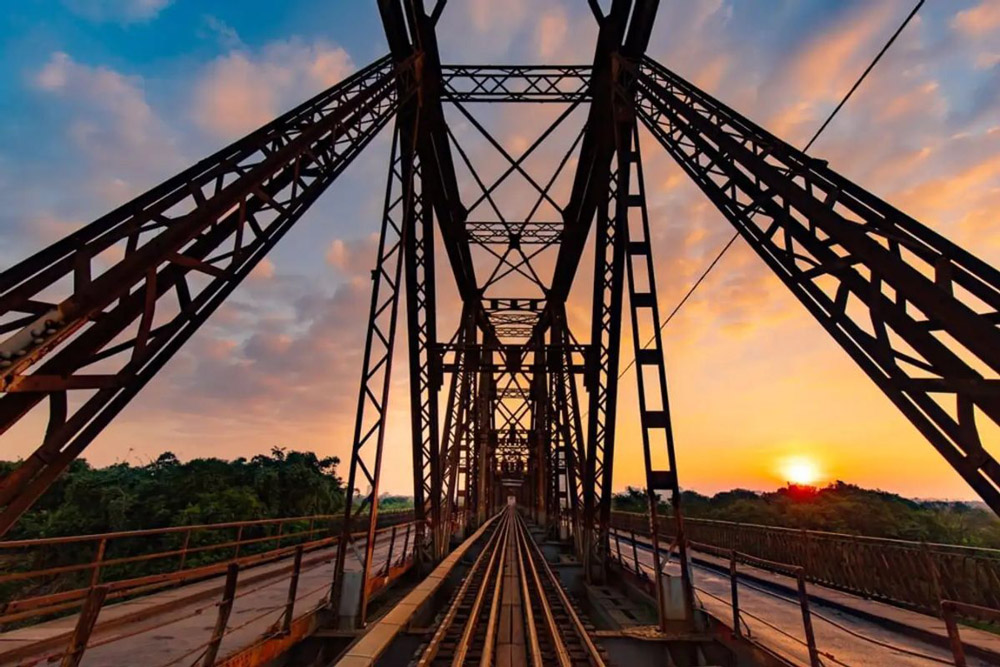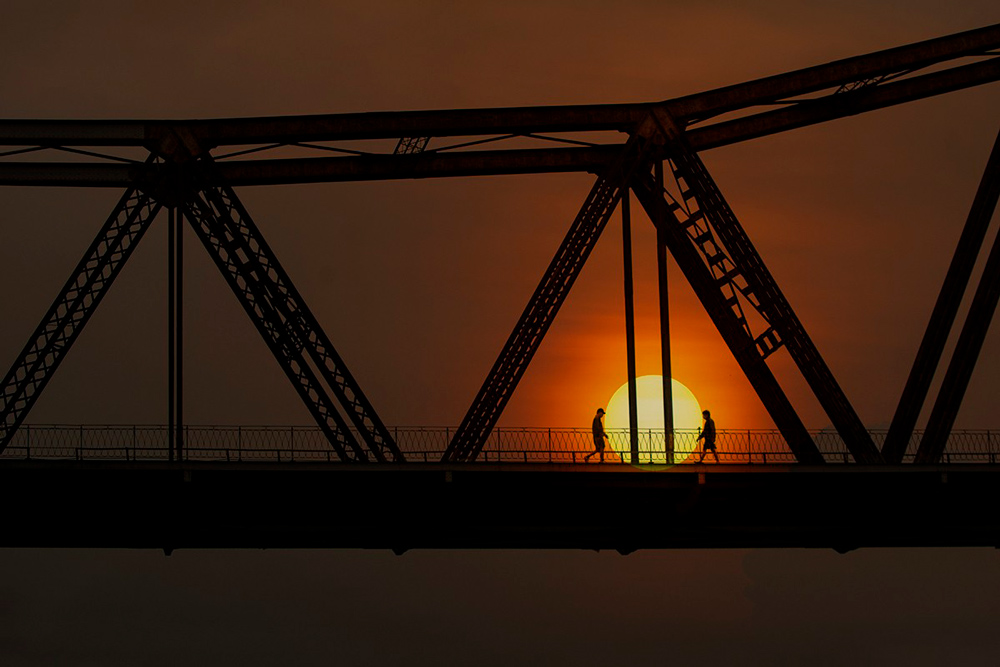More than just a river crossing, Long Bien Bridge is a symbol of Hanoi's resilience, a testament to its history, and a unique architectural landmark that has stood the test of time. Imagine a bridge forged from steel, weathered by time, yet still standing strong, carrying the weight of history on its sturdy shoulders. Connecting the Hoan Kiem and Long Bien districts, this iconic structure has witnessed the ebb and flow of Hanoi's fortunes, surviving wars and emerging as a symbol of the city's enduring spirit. Long Bien Bridge is not just a way to get from one place to another; it's an experience, a journey through time, offering breathtaking views and a tangible connection to Vietnam's past. This comprehensive guide will delve into the fascinating story of Long Bien Bridge, exploring its unique design, its role during times of conflict, and its significance to the people of Hanoi. We'll also provide you with all the practical information you need to plan your visit and discover why this historic bridge continues to captivate both locals and visitors alike. Get ready to explore one of Hanoi's most enduring and evocative landmarks.

Long Bien Bridge is far more than just a way to cross the Red River; it's an iconic symbol of Hanoi, a testament to French engineering prowess, and a witness to some of the most pivotal moments in Vietnam's history. Its fame is rooted in its unique design, its wartime resilience, and its enduring presence in the city's landscape.
The story of Long Bien Bridge begins in the late 19th and early 20th centuries, during the height of French colonial rule.
Long Bien Bridge history is full of stories. The bridge has played a significant role in the city's development and has witnessed key moments in Vietnam's journey to independence. It connected Hanoi to other provinces.
Long Bien Bridge has borne witness to the tumultuous events of the 20th century, playing a crucial role in both the First Indochina War and the Vietnam War.
Long Bien Bridge has endured through war, weathered countless storms, and witnessed the transformation of Hanoi from a colonial outpost to a vibrant, modern capital.
Here are a few facts that highlight the bridge's significance:
Long Bien Bridge is more than just a physical structure; it's a symbol of Hanoi's history, its resilience, and its enduring spirit. It's a bridge that connects not only two parts of the city but also the past and the present, making it a truly iconic landmark.
Long Bien Bridge offers more than just a way to cross the Red River; it's an immersive journey through time, a chance to connect with Hanoi's past and present in a truly unique way.
Many visitors wonder, "Can you walk across Long Bien Bridge?" The answer is a resounding yes! Pedestrians are allowed to walk across the bridge, sharing the space with bicycles and motorbikes. There is a pathway for pedestrians.
A Walk to Remember: Walking or cycling across Long Bien Bridge is an unforgettable experience. As you traverse its historic spans, you'll feel the vibrations of passing trains, take in panoramic views of the Red River, and witness scenes of daily life unfolding below. It's a chance to connect with the city on a more intimate level, feeling the pulse of Hanoi beneath your feet.
If you're planning to walk or cycle across, you might be asking, "How long is Long Bien Bridge?"
A journey across Long Bien Bridge is filled with captivating sights and unique experiences:
Long Bien Bridge is not just a crossing; it's a destination in itself. It's a place where you can connect with history, witness stunning views, and observe the daily life of Hanoi from a unique perspective. Whether you choose to walk, cycle, or simply stand and admire the view, a visit to this iconic bridge is sure to be a memorable part of your Hanoi experience.
Hanoi is a city defined by its rivers, and as such, it's home to numerous bridges, each with its own story to tell. But among these, one stands out as a true icon, steeped in history and beloved by the city's residents: the Long Bien Bridge. While other bridges serve as vital transportation links, Long Bien Bridge transcends its functional role, holding a special place in the hearts of Hanoians and captivating visitors with its unique character.
Long Bien Bridge is, without a doubt, the most famous and historically significant bridge in Hanoi. Its weathered steel structure, a veteran of countless conflicts and a witness to the city's transformation, has become an enduring symbol of Hanoi's spirit. Its unique cantilever design and its survival through wartime bombings have cemented its place as a legendary landmark, far surpassing the recognition of any other bridge in the city.
While Long Bien Bridge holds a unique position in Hanoi's history and cultural landscape, it's worth acknowledging the other bridges that contribute to the city's connectivity and character:
Comparison:
These other bridges are primarily functional, designed for modern transportation needs. They showcase contemporary engineering and contribute to the city's development but lack the historical depth and cultural significance that sets Long Bien Bridge apart. Long Bien Bridge is a living relic, a testament to a bygone era, and a symbol of resilience that resonates deeply with the Vietnamese people.
The Verdict:
While Hanoi's other bridges are essential components of the city's infrastructure, Long Bien Bridge stands alone as a true icon. Its fame is not just about its physical presence but also about the stories it embodies, the history it has witnessed, and the emotions it evokes. It's a bridge that connects not just two sides of a river but also the past and the present, making it the most famous and arguably the most beloved bridge in Hanoi. When you visit Hanoi, crossing Long Bien Bridge is more than just a commute; it's an experience, a journey through time, and a connection to the soul of the city.
To ensure your visit to Long Bien Bridge is both memorable and safe, here are some practical tips to keep in mind:
Choosing the right time to visit Long Bien Bridge can significantly enhance your experience.
While Long Bien Bridge is generally safe for visitors, it's important to be mindful of your surroundings.
Long Bien Bridge is easily accessible from various parts of Hanoi.
From the Old Quarter: The bridge is located at the edge of the Old Quarter, making it a walkable distance (around 15-20 minutes) from many hotels in that area.
Long Bien Bridge's location makes it easy to combine your visit with other nearby attractions.
By following these tips and incorporating a visit to Long Bien Bridge into a broader exploration of Hanoi's attractions, you can create a truly memorable and enriching travel experience. This historic bridge offers a unique perspective on the city, a chance to connect with its past, and a journey across the iconic Red River.
Long Bien Bridge is far more than just a means of crossing the Red River; it's a powerful symbol of Hanoi's past, a testament to its resilience, and a unique vantage point from which to observe its present. Its weathered steel girders whisper tales of a bygone era, while the daily rhythm of life unfolding along its length connects you to the city's vibrant pulse. From its remarkable history as a French engineering marvel to its enduring presence through times of war and peace, Long Bien Bridge offers an experience unlike any other in Hanoi. We encourage you to walk or cycle across its historic spans, soak in the panoramic views, and immerse yourself in the unique atmosphere of this iconic landmark. It's a journey that will undoubtedly leave a lasting impression.
To elevate your Hanoi adventure and ensure it's tailored to your individual interests, consider the expertise of Asia Mystika. We craft tailor-made experiences that go beyond standard itineraries, allowing you to delve deeper into the heart of Vietnam's culture and history, including unique perspectives on landmarks like Long Bien Bridge. Our local experts provide invaluable insights, revealing hidden stories and authentic local encounters that will enrich your journey. With Asia Mystika, you can explore with confidence, knowing that every detail is meticulously planned by a trustworthy team dedicated to creating unforgettable memories. And our commitment to value for money ensures that your investment unlocks an extraordinary and enriching adventure.
Ready to experience the magic of Long Bien Bridge and uncover the many other treasures of Vietnam? Explore our inspiring range of Vietnam tour packages and let us help you design your perfect itinerary. We invite you to share your own Long Bien Bridge experiences, reflections, or any questions you may have in the comments below. Let your journey across this historic bridge and through the heart of Vietnam begin!


